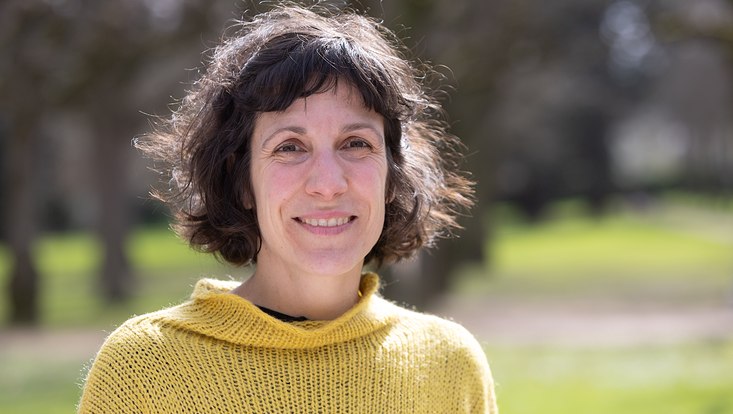Dr. Jana Schuster

Photo: Jörg Heupel
Curriculum
Jana Schuster is a literary scholar at the Institute for German Studies, Comparative Literature and Cultural Studies at the University of Bonn. Her habilitation (i.e. postdoctoral degree) project engages with the aesthetics and anthropology of the atmosphere in German literature, as well as philosophy and art theory, in the 18th and 19th century. She studied German philology and history at Ludwig-Maximilians-Universität Munich and King’s College London, received her PhD at Freie Universität Berlin for a thesis on Rainer Maria Rilke’s Poetics of Movement (Freiburg i.Br.: Rombach, 2011), and was a Postdoctoral Fellow at Friedrich Schlegel Graduate School of Literary Studies Berlin. Her research interests include poetry; trans- and intermedial aesthetics of space, time and movement; literature and knowledge (meteorology, geology, cosmology); anthropology and aesthetics of the atmosphere.
Publications (selection)
- Josephe Maria Asteron. Kleists koloniale Heilsgeschichte. In: DVjs 96/4 (2022), pp. 361-409. https://doi.org/10.1007/s41245-022-00149-7.
- Meteorologie/Mediologie. Luft in der Lyrik des 18. Jahrhunderts. In: Urs Büttner/Michael Gamper (Eds.): Verfahren literarischer Wetterdarstellung. Meteopoetik – Literarische Meteorologie – Meteopoetologie. Berlin 2021, pp. 43-68. https://www.degruyter.com/document/doi/10.1515/9783110624489-003/html.
- Maß und Gesetz des Unmerklichen. Kraft, Zeit und Intensität bei Stifter. In: Davide Giuriato/Sabine Schneider (Eds.): Stifters Mikrologien. Stuttgart 2019, pp. 31-53. https://doi.org/10.1007/978-3-476-04884-4_3.
- (Ed.) Zeit und Zeiten in Stifters Nachsommer (= Jahrbuch des Adalbert-Stifter-Instituts des Landes Oberösterreich JASILO 28/2021). Linz 2021.
- (Eds. with Alexander Kling) Zeiten der Materie. Verflechtungen temporaler Existenzformen in Literatur und Wissenschaft (1770-1900). Hannover 2021.
Research project: Atmospheric Diffusion of Light as a Primal Phenomenon of Aesthetics
The atmosphere, first natural medium of light, is the figure of a double latency, inasmuch as the transparent air and the invisible light do not appear but interwoven with each other. Not only in clouds, dust and mist, but also in the sky blue and the red sky of dawn and sunset, the atmospheric reservoir of imperceptibly effective forces and ethereal bodies gains in an aisthetic markedness, which the subtle light effects of modern landscape painting suggest as the unavailable aura of aesthetic phenomena. The project investigates how the atmospheric plays of light and colour in painting wield crucial influence on the theory formation of philosophical aesthetics in the 18th century, and how the atmosphere, thereto dormant within the discourse, is concretised to an aistheton and even to a paradigm of the aesthetic realm around 1800 in Herder and Goethe.
Research results: Atmospheric Diffusion of Light as a Primal Phenomenon of Aesthetics
In the history of the earth, the forces of light, heat, electricity and magnetism, which were much discussed around 1800, have a specific place: the earth’s atmosphere. Herder, in the introductory section on natural history of his Ideas on the Philosophy of the History of Mankind, understands the atmosphere as the "epitome" of all sensory phenomena of those mostly latent relations of force. In Sloterdijk's sense, this makes 'explicit' a knowledge of the 'atmosphere' (a coinage of astronomically based optics of the 17th century), which modern painting has been elaborating since Leonardo for the light effects of the air.
Within the framework of classical rhetorical arguments of evidentia, this painterly expertise also finds its way into philosophical aesthetics. Baumgarten contrasts the realm of the logical with the genuine 'sphere' of the 'aesthetic horizon', the specifically 'aesthetic light' of which appears mitigated, but all the more vivid in comparison to rational perspicacity. Its symbol is the dawn (aurora) transitioning from the darkness of night to the brightness of noon. Leibniz's clear-confused cognition of the aesthetic thus finds its natural analogue in atmospherically diffuse light.
Baumgarten's lux aesthetica becomes vividly concrete in Herder who, in Die Älteste Urkunde des Menschengeschlechts (The Oldest Document of the Human Race), celebrates the dawn as the medium of the only human-friendly parousia of divine light. The 'primordial phenomenon' of dawn becomes the paradigm of an aesthetic that – in accordance with Leibniz's petites perceptions and Baumgarten's 'extensive clarity' – unfolds in an incessant, energetically "gently ascending progression", which is congenially expressed in the successively composed medium of poetry.
Also Goethe's cosmogonic Divan-poem Wiederfinden figures the dawning of the aesthetic in the aurora that elicits "from the murky [dem Trüben] a resounding play of colours". In the Aristotelian terms of Goethe’s Colour Theory, colour as the 'actus' of light is thus being stimulated out of the diaphanous. Finally, when William Turner presents Light and Colour as elementary events of painting in the illuminated media of air and water, the atmosphere – in a once again cosmogonic, post-diluvian scenario – manifests itself as a highly energetic, now thermodynamically conceived birthplace of the aesthetic.
